Space pictures! See our space image of the day
Earth from space never disappoints.
Space can be a wondrous place, and we've got the pictures to prove it! Take a look at our favorite space pictures here, and if you're wondering what happened to today in space history don't miss our On This Day in Space video show here!
Blue Origin's New Glenn looks stunning shrouded in red smoke upon launch

Thursday, Jan. 16, 2025: Jeff Bezos' Blue Origin massive New Glenn rocket looked absolutely stunning in this dramatic image taken during launch.
New Glenn blasted off on its virgin flight at 2:03 a.m. EST (0703 GMT) on Thursday (Jan. 16) from Cape Canaveral Space Force Station on Florida's Space Coast.
"We got to orbit safely,” Ariane Cornell, vice president of in-space systems at Blue Origin, said in the company's launch webcast. "Congratulations, everybody. What a day!"
Read More: Jeff Bezos' Blue Origin launches massive New Glenn rocket into orbit on 1st flight (video)
Space X launches two lunar landers igniting a fiery trail in the sky
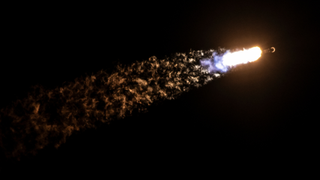
Wednesday, Jan.15, 2025: A Falcon 9 rocket cuts a blazing smoky trail across the early morning sky over the Florida Space Coast this morning.
The Falcon 9, which launched at 1:11 a.m. EST (0611 GMT) from NASA's Kennedy Space Center (KSC), was carrying not one but two private lunar landers,
Firefly Aerospace's Blue Ghost and iSpace's Resilience.
Around 8.5 minutes after launch, the Falcon 9's first stage returned to Earth, touching down on SpaceX's droneship, "Just Read the Instructions," stationed in the Atlantic Ocean.
Get the Space.com Newsletter
Breaking space news, the latest updates on rocket launches, skywatching events and more!
Read More: SpaceX launches 2 private lunar landers to the moon (photos)
Zodiacal light and the Milky Way captured from the International Space Station

Tuesday, January 14, 2025: NASA astronaut Don Petit captured a stunning image of zodiacal light and our home galaxy, the Milky Way, from the International Space Station (ISS).
Petit shared the image on his X feed, writing: "One photo with Milkyway, Zodiacal light, @Starlink satellites as streaks, stars as pinpoints, the atmosphere on edge showing OH emission as burned umber (my favorite Crayon color), soon to rise sun, and cities at night as streaks. Taken two days ago from Dragon Crew 9 vehicle port window."
Zodiacal light is a somewhat mysterious faint, elongated cone-shaped emission that can sometimes seen in the night sky. The prevailing theory is that this emission is caused by sunlight reflected off particles of ice and dust within the plane of the solar system.
Monday, January 13: Orbital sunrise

Monday, January 13, 2025: Seeing Earth from space never disappoints.
That's been especially true over the last several months, as the International Space Station (ISS) has welcomed NASA astronauts who are so enthusiastic about astrophotography aboard the orbital laboratory.
This photograph was taken from the ISS as the station orbited some 259 miles (416 km) above the Pacific Ocean, around 500 miles (804 km) north of the Hawaiian islands. The photo captures the terminator, the line that separates night from day on Earth.
Hey, Mercury... just passing through
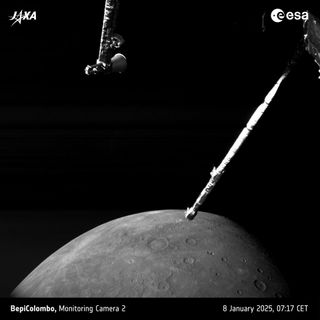
Friday, January 10, 2025: The BepiColombo spacecraft has made its sixth and final flyby of the closest planet to the sun, Mercury, capturing some incredible images of the tiny world. The photos offer tantalizing hints about some of the mysteries BepiColombo will investigate when it moves into orbit around the planet next year. During the flyby, BepiColombo, which was launched on Oct. 20, 2018, came to within around 185 miles (295 kilometers) of Mercury's nightside, facing away from the sun. Around seven minutes later, the ESA/JAXA spacecraft flew over the tiny planet's north pole. — Robert Lea
Read more: Mercury looks stunning in images from BepiColombo spacecraft's 6th and final flyby
Starship in the dead of night

Thursday, January 9, 2025: SpaceX is gearing up for the next test flight of its Starship megarocket, with just a few days to go. The company rolled Starship's 165-foot-tall (50-meter-tall) upper stage — known as Starship, or simply "Ship" — out to the launch pad at its Starbase site in South Texas early this morning. SpaceX founder and CEO Elon Musk announced the milestone in a post on X. That update featured this photo and others of the transport, which occurred during predawn hours. — Mike Wall
Read more: SpaceX rolls Starship out to pad ahead of Flight 7 test launch (photos)
Wildfire furry seen from space

Wednesday, January 8, 2025: California, and the National Oceanic and Atmospheric Administration's (NOAA) satellites continue to monitor the location of the fire and smoke across the region. The Palisades Fire, which began Tuesday morning (Jan. 7), grew to just under 3,000 acres in less than 24 hours. Tens of thousands of people have been forced to evacuate their homes and businesses, with more evacuation orders likely to be issued with the continued threat of powerful wind gusts.
NOAA has two different types of satellites working in tandem to keep a watchful eye on the wildfire; Geostationary Operational Environmental Satellite (GOES) and the Joint Polar Satellite System (JPSS). In the time lapse captured by NOAA's GOES-18 satellite, pictures from its Advanced Baseline Imager (ABI) show the location of the fire, how it grew in size and intensity over time, and where the winds were blowing the smoke plume. — Meredith Garofalo
Read more: Satellites watch as LA wildfires burn out of control in California (video)
In a star-studded galaxy far, far away...
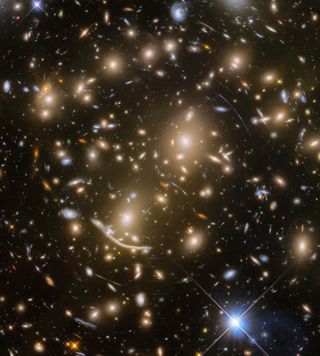
Tuesday, January 7, 2025: New year, new milestone: A cosmic quirk of nature has allowed the James Webb Space Telescope (JWST) to capture images of 44 individual stars in a galaxy halfway across the observable universe — this region is so distant that astronomers once deemed identifying individual stars in it impossible, like using binoculars to spot dust grains inside craters on the moon. — Sharmila Kuthunur
Read more: James Webb Space Telescope spots record-breaking collection of stars in far-flung galaxy
Sol 1379: A Martian sunrise

Monday, January 6, 2025: The blazingly bright sun glares into the lens of Left Navigation Camera (Navcam) of NASA's Perseverance rover on Mars. Shining above the rolling hills of the red planet, the sun is seen here, over-exposed, hanging in the hazy Martian sky.
Perseverance sent this image back to Earth yesterday, on Sol 1379 — the number of Martian days the rover has been on the planet.
Related: Up and over! NASA's Mars rover Perseverance reaches rim of its Jezero Crater home (video)
Aurora Borealis keeps Santa awake in his down time
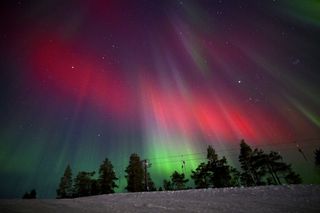
Friday, January 3, 2025: Don't you just hate it when you finish a long shift at work and some disturbance keeps you from nabbing some much-needed Zs? If so, spare a thought for Santa.
No sooner does St. Nick return to his home in Lapland for a well-earned rest after his annual Christmas Eve delivery schedule and the Northern Lights light up the skies with a breathtaking display. This light show, also known as the "Aurora Borealis," was captured on Wednesday (Jan. 1) from a ski slope in Levi, Lapland.
Rivaling any human-orchestrated firework display set for the New Year, this cosmic light show came courtesy of charged particles from the sun, blasted out in two coronal mass ejections (CME), striking Earth's planet-encompassing magnetic field.
Should Santa have attempted to get some rest from these unignorably stunning auroral displays, moving further south would have done little good. The celestial fireworks stretched as far toward the equator as California in the U.S., Austria, and Germany in Europe.
Read More: New Year's northern lights delight as powerful solar storms spark auroras across central US and Europe (photos)
Blue Origin fires up New Glenn rocket
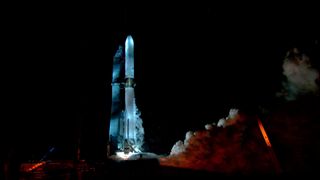
Thursday, January 2, 2025: Blue Origin conducted the first hot fire test of its fully integrated New Glenn rocket on Dec. 27, 2024.
The 24-second test saw the upcoming New Glenn rocket fire all seven of its engines, the first time the company "operated the entire flight vehicle as an integrated system," Blue Origin wrote in an update.
The hotfire test comes ahead of New Glenn's planned first launch, which could some as soon as this month. The mission, known as NG-1, will see the massive new rocket launch the Blue Ring Pathfinder, a demonstrator for Blue Origin's versatile new spacecraft bus designed to deliver payloads to geostationary orbit (GEO) and beyond.
Read more: Blue Origin hot fires New Glenn rocket for first time and scores FAA license for test launch
Can't find the date you're looking for? It may have been a weekend or holiday, when we don't normally update our Image of the Day. Check out the IOD Archives for more!
Image of the Day Archives
Image of the Day 2024 Archive
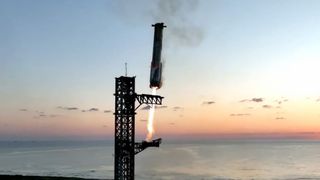
Image of the Day 2023 Archive
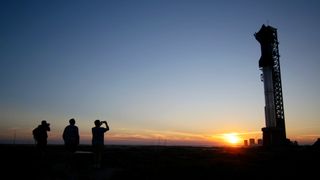
Image of the Day 2022 Archive
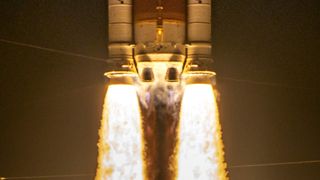
Image of the Day 2021 Archive
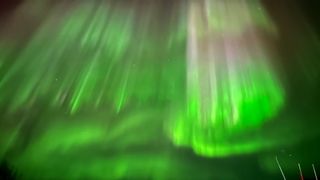
Image of the Day 2020 Archive

Image of the Day 2019 Archive
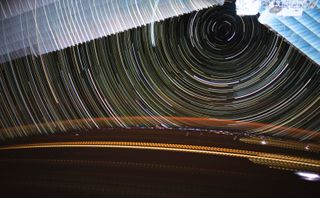
Join our Space Forums to keep talking space on the latest missions, night sky and more! And if you have a news tip, correction or comment, let us know at: community@space.com.

Space.com is the premier source of space exploration, innovation and astronomy news, chronicling (and celebrating) humanity's ongoing expansion across the final frontier. Originally founded in 1999, Space.com is, and always has been, the passion of writers and editors who are space fans and also trained journalists. Our current news team consists of Editor-in-Chief Tariq Malik; Editor Hanneke Weitering, Senior Space Writer Mike Wall; Senior Writer Meghan Bartels; Senior Writer Chelsea Gohd, Senior Writer Tereza Pultarova and Staff Writer Alexander Cox, focusing on e-commerce. Senior Producer Steve Spaleta oversees our space videos, with Diana Whitcroft as our Social Media Editor.
-
rod ReplyThe Exoplanets Channel said:The images are truly breath-taking.
The Exoplanets Channel, what star and reddish exoplanet is shown in your picture, looks like about 8" angular separation? I use this site as my canonical reference to exoplanets, The Extrasolar Planets Encyclopaedia Currently 4150 exoplanets are listed. -
swiggly ReplyThe Exoplanets Channel said:The images are truly breath-taking.
My Comet Image:
Neowise -
rod Reply
This is a very good image here. In enjoyed some recent views of NEOWISE using my 90-mm telescope at 40x early, shortly after 0415 EDT. Bifurcated tail obvious too.swiggly said:My Comet Image:
Neowise -
Helio The IOD image for yesterday of the Veil nebula is stunning! The graphics are such that it's almost as if it has an oil film on top. It has both 3D and texture feel to it.Reply -
Astro.Letizia I hope they start posting these daily again! I always start my day off with the newest image but it's been a couple of months now :(Reply